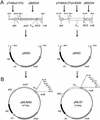Construction and evaluation of plasmid vectors optimized for constitutive and regulated gene expression in Burkholderia cepacia complex isolates
- PMID: 12450816
- PMCID: PMC134411
- DOI: 10.1128/AEM.68.12.5956-5964.2002
Construction and evaluation of plasmid vectors optimized for constitutive and regulated gene expression in Burkholderia cepacia complex isolates
Abstract
Genetic studies with Burkholderia cepacia complex isolates are hampered by the limited availability of cloning vectors and by the inherent resistance of these isolates to the most common antibiotics used for genetic selection. Also, some of the promoters widely employed for gene expression in Escherichia coli are inefficient in B. cepacia. In this study, we have utilized the backbone of the vector pME6000, a derivative of the pBBR1 plasmid that was originally isolated from Bordetella bronchiseptica, to construct a set of vectors useful for gene expression in B. cepacia. These vectors contain either the constitutive promoter of the S7 ribosomal protein gene from Burkholderia sp. strain LB400 or the arabinose-inducible P(BAD) promoter from E. coli. Promoter sequences were placed immediately upstream of multiple cloning sites in combination with the minimal sequence of pME6000 required for plasmid maintenance and mobilization. The functionality of both vectors was assessed by cloning the enhanced green fluorescent protein gene (e-gfp) and determining the levels of enhanced green fluorescent protein expression and fluorescence emission for a variety of clinical and environmental isolates of the B. cepacia complex. We also demonstrate that B. cepacia carrying these constructs can readily be detected intracellularly by fluorescence microscopy following the infection of Acanthamoeba polyphaga.
Figures




Similar articles
-
An expression vector containing a rhamnose-inducible promoter provides tightly regulated gene expression in Burkholderia cenocepacia.Plasmid. 2005 Nov;54(3):219-28. doi: 10.1016/j.plasmid.2005.03.004. Epub 2005 May 31. Plasmid. 2005. PMID: 15925406
-
Green and red fluorescent protein vectors for use in biofilm studies of the intrinsically resistant Burkholderia cepacia complex.J Microbiol Methods. 2004 Apr;57(1):95-106. doi: 10.1016/j.mimet.2003.12.007. J Microbiol Methods. 2004. PMID: 15003692
-
Development of inducer-free expression plasmids based on IPTG-inducible promoters for Bacillus subtilis.Microb Cell Fact. 2017 Jul 25;16(1):130. doi: 10.1186/s12934-017-0747-0. Microb Cell Fact. 2017. PMID: 28743271 Free PMC article.
-
A genetic analysis system of Burkholderia cepacia: construction of mobilizable transposons and a cloning vector.Gene. 1996 Oct 3;174(2):191-4. doi: 10.1016/0378-1119(96)00038-8. Gene. 1996. PMID: 8890733
-
Isolation of a gene from Burkholderia cepacia IS-16 encoding a protein that facilitates phosphatase activity.Curr Microbiol. 2000 Jun;40(6):362-6. doi: 10.1007/s002840010071. Curr Microbiol. 2000. PMID: 10827277
Cited by
-
Orderly Replication and Segregation of the Four Replicons of Burkholderia cenocepacia J2315.PLoS Genet. 2016 Jul 18;12(7):e1006172. doi: 10.1371/journal.pgen.1006172. eCollection 2016 Jul. PLoS Genet. 2016. PMID: 27428258 Free PMC article.
-
Regulation of phenylacetic acid degradation genes of Burkholderia cenocepacia K56-2.BMC Microbiol. 2009 Oct 18;9:222. doi: 10.1186/1471-2180-9-222. BMC Microbiol. 2009. PMID: 19835630 Free PMC article.
-
Chlorophenol hydroxylases encoded by plasmid pJP4 differentially contribute to chlorophenoxyacetic acid degradation.Appl Environ Microbiol. 2006 Apr;72(4):2783-92. doi: 10.1128/AEM.72.4.2783-2792.2006. Appl Environ Microbiol. 2006. PMID: 16597983 Free PMC article.
-
A MarR family transcriptional regulator and subinhibitory antibiotics regulate type VI secretion gene clusters in Burkholderia pseudomallei.Microbiology (Reading). 2018 Sep;164(9):1196-1211. doi: 10.1099/mic.0.000697. Epub 2018 Jul 27. Microbiology (Reading). 2018. PMID: 30052173 Free PMC article.
-
A dedicated cytoplasmic container collects extrachromosomal DNA away from the mammalian nucleus.Mol Biol Cell. 2023 Oct 1;34(11):ar105. doi: 10.1091/mbc.E23-04-0118. Epub 2023 Aug 9. Mol Biol Cell. 2023. PMID: 37556227 Free PMC article.
References
-
- Abe, M., M. Tsuda, M. Kimoto, S. Inouye, A. Nakazawa, and T. Nakazawa. 1996. A genetic analysis system of Burkholderia cepacia: construction of mobilizable transposons and a cloning vector. Gene 174:191-194. - PubMed
-
- Amer, A. O., and M. A. Valvano. 2002. Conserved aspartic acids are essential for the enzymatic activity of the WecA protein initiating the biosynthesis of O-specific lipopolysaccharide and enterobacterial common antigen in Escherichia coli. Microbiology 148:571-582. - PubMed
-
- Antoine, R., and C. Locht. 1992. Isolation and molecular characterization of a novel broad-host-range plasmid from Bordetella bronchiseptica with sequence similarities to plasmids from gram-positive organisms. Mol. Microbiol. 6:1785-1799. - PubMed
-
- Bevivino, A., C. Dalmastri, S. Tabacchioni, L. Chiarini, M. L. Belli, S. Piana, A. Materazzo, P. Vandamme, and G. Manno. 2002. Burkholderia cepacia complex bacteria from clinical and environmental sources in Italy: genomovar status and distribution of traits related to virulence and transmissibility. J. Clin. Microbiol. 40:846-851. - PMC - PubMed
-
- Bevivino, A., S. Sarrocco, C. Dalmastri, S. Tabacchioni, C. Cantale, and L. Chiarini. 1998. Characterization of a free-living maize-rhizosphere population of Burkholderia cepacia: effect of seed treatment on disease suppression and growth promotion in maize. FEMS Microbiol. Ecol. 27:225-237.
Publication types
MeSH terms
Substances
LinkOut - more resources
Full Text Sources
Other Literature Sources
Molecular Biology Databases
Research Materials

